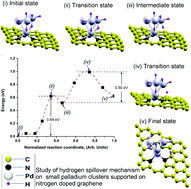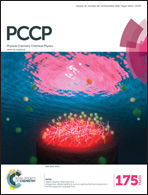Study of the interplay between N-graphene defects and small Pd clusters for enhanced hydrogen storage via a spill-over mechanism†
Abstract
The hydrogen spill-over mechanism was studied by applying Density Functional Theory. We used small palladium clusters to act as the catalyst supported on the substrate (comprised of pyridinic and pyrrolic nitrogen doped graphene), in order to study hydrogen dissociation, migration and diffusion. Charge transfer and strong binding between the catalyst and the substrate lead to dissociated states of H2 and prevent clusters from detaching and coalescing. In dissociated cases of H2 on Pd clusters, energy barriers below 0.6 eV were found. Likewise, concerning hydrogen migration from the catalyst to the substrate, energy barrier values of 0.8 eV (pyridinic defect) and 0.5 eV (pyrrolic defect) were apparent in the case of the Pd4 cluster at full hydrogen saturation. This indicates that hydrogen dissociation and migration may occur spontaneously at room temperature. This result shows that the interaction between the defects and the small metal clusters may explain the role that defects play in hydrogen migration from the catalyst to the substrate. Subsequently, it was found that thermal desorption does not limit chemisorbed hydrogen diffusion on the substrate. This work may thus help to determine experimental strategies with the capacity to enhance hydrogen storage.


 Please wait while we load your content...
Please wait while we load your content...